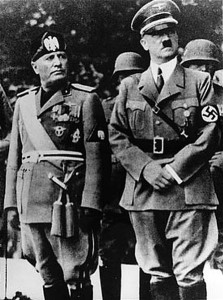Dictators. We tend to think of Hitler and Mussolini as having similar ideals and regimes based on the sole fact that they are both dictators. However, when analyzing their doctrines’ theories, one can see their goals and philosophies were not similar. In Hitler’s The 25 Points 1920: An Early Nazi Program the focus is on the purification of Germany. Contrastingly, in Benito Mussolini: What is Fascism, the focus is on the State’s importance exercised through expansion.
Mussolini’s fascist state focuses on the State’s absolutism, expansion, and emphasis on man’s character. Mussolini came from a socialist background as an editor for a socialist newspaper. Once appointed Prime Minister in 1922, his career began in state leadership. In Mussolini’s What is Fascism he placed an emphasis on heroism of the man. He, as the spokesperson of the Fascist regime, believed man should not have any economic motive but rather see life as “duty and struggle and conquest”. For what purpose should man be dutiful and charismatic? The State, of course! Mussolini believed the State was the foundation of Fascism. As man provides ethics (discipline, duty, sacrifice), the State is able to expand.
Hitler’s philosophy focuses on maintaining the German population in all aspects. From the formation of a national army to restrictions on immigration, the Nazi program aimed to unify the Germans into one single ideal of biology, culture, policy, and geography. They attained this by an emphasis on nationality. Although in The 25 Points there is a demand of land and/or colonization for the German people, the physical land is not a central point. Rather, the significance is this sense of German priority. Contrasting to Mussolini and Fascism, the Nazi party placed an emphasis on economy. Hitler demanded nationalization of some industries and a division of profits for others.
The collective priority of the State over the individual is shared between both Mussolini and Hitler. Although they achieved “common good” differently through their individual philosophies and actions, the overarching concept of commonality is evident in both regimes.
Mussolini demands the deprivation of “all useless and possibly harmful freedom” but the retention of essential liberty. What are some examples of “useless freedom”? Do you think it is possible to place such a specific margin of liberty on a population?


The concept of “useless and possibly harmful freedom” struck me as a strange, out of place catch-22 in Mussolini’s demands, especially when juxtaposed with the quote used earlier in your post regarding the economy (“duty and struggle and conquest”). In one’s duty, struggle, and conquest, is one not inherently acting out of their own free will?
To answer the question you raised (which is a great philosophical postulate): there is no such thing as useless freedom, and it is impossible to place a specific margin of liberty on a population. By restricting freedom or rights in any regard, a society can no longer be considered free. Granting “some liberty” is similar to saying (to quote George Orwell) “all are created equal, but some more equal than others.”
I think Mussolini viewed democracy as “useless freedom.” I think his belief in complete authoritarianism comes from his view of humans. He claims that everyone must have essential liberty but not everyone is able to maintain their own essential liberty. In his opinion, some people just should not be trusted with decision making; one’s freedom is negatively related to his/her ability to freely manage it (that’s confusing).
Also in response to your question at the end of the first paragraph, I do not think that people are always acting on their own free will. Modernity enhanced the state’s ability to coerce and manipulate the masses into doing things normally against their own free will.
To answer your last question, I believe that it is not possible to place a specific margin of liberty, particularly if you are attempting to establish a fascist or totalitarian state. If you are dictator and you want control, you will not give an inch to the population. In Nazi Germany, Hitler would not have given the German population room for disobedience, beliefs in other parties besides the Nazi Party, nor would he have given any room for freedom of speech. If you said something, did something in Nazi Germany that could be taken in a negative light against the state, you most likely would have been sent off to a concentration camp as an ‘enemy of the state’. In Italy, a margin of liberty for the people on the part of Mussolini is the reason why he did not last as long as Hitler. Mussolini did not have complete control as Hitler did in Germany in part because of his belief “retention of essential liberty.” In my opinion, If a dictator is going to stay in power, he will not give an inch to the population.
I do not think that there is anything that can be defined as a “useless freedom”. By using this term I think he was trying emphasize that the state is bigger than the individual. The central figure places a specific margin of liberty, however the size of the margin is decided upon by the leader. Like Henry noted above, I think that Hitler had more total control over the people compared to Mussolini which allowed him to remain in power longer. This was in part due to a much, much smaller margin of liberty.